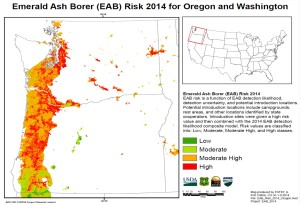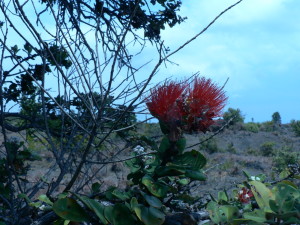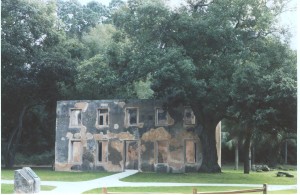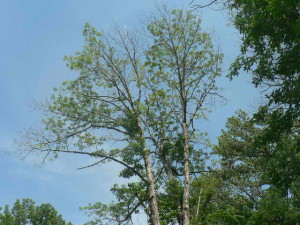
We all know that the emerald ash borer (EAB) has caused enormous damage in the approximately 25 years since it was first introduced to Michigan and Ontario. (For more information, see writeup here. In brief, EAB has killed “untold millions” of ash trees across more than 170,000 square miles in 25 states and two provinces (map).
Apparently all North American ash are vulnerable – more than 20 species in Canada, the U.S., and Mexico. The genus Fraxinus is one of the most widespread on the continent. These trees’ deaths are causing changes in forest species composition, structure, and function. Hundreds of arthropod species that depend on the genus will be affected.
Nevertheless, forests with important ash components are still outside the infested area and deserve greater protection.
Also, ash trees are among the most common ornamental trees planted in U.S. cities and towns. The death of these trees show us that EAB also has imposed billions of dollars in costs on people who had no direct role in the insect’s introduction and spread. Several studies have proposed estimates:
o Communities in Ohio would likely incur costs up to $4 billion if all ash trees on public land were removed and replaced (Sydnor et al. 2007).
o Communities in four Midwestern states would have to pay an estimated $26 billion to remove and replace as trees growing in parks, private lands, and along streets (Sydnor et al. 2011).
o The cost of treating or removing only half of the affected urban and suburban trees across the anticipated range of EAB during the 10-year period from 2009 to 2019 would be $20 billion (Kovacs et al. 2011).
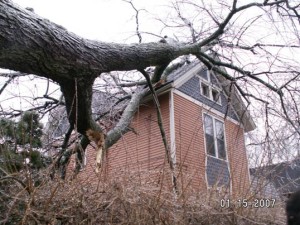
Over the 14 years since EAB was detected, scientists have learned much about the insect, its hosts, and its management. Early detection of new outbreaks remains difficult. However, traps and lures are more effective than even a few years ago. Other new tools also have been deployed, including strategies for protecting high value trees, and slowing the rate of ash mortality in urban and natural forests.
Four biocontrol agents have been released at sites across the invaded area, although it is too early to know how effective they will be in suppressing EAB populations and protecting ash trees.
The systemic insecticide emamectin benzoate controls EAB for up to three years. This means that municipalities and property owners can now save mature ash trees. Studies show that treating such trees costs less than removing dead trees and planting replacements (Herms and McCullough 2014).
Scientists in Ohio, Michigan, Kentucky, and Massachusetts are testing whether treating just some trees in forest settings can help protect nearby ashes.
One of the most important potential responses to this insect is to breed resistant ash trees. The USDA Forest Service and USDA APHIS have funded such efforts since 2005 – only three years after the insect was detected. Scientists have demonstrated that some ash species that have coevolved with the insect in Asia – especially Manchurian ash – are resistant to EAB attack. More recently, they have been studying how to cross-breed the resistant and non-resistant species and how to evaluate the hybrid progeny for genetic resistance.
Dr. Pierluigi (Enrico) Bonello and others at Ohio State and Wright State University are studying how Manchurian ash trees resist EAB attack. Their focus is on the chemicals present in the trees’ tissues – how they differ in Manchurian ash compared to North American species. These studies have found that Manchurian ash trees contain chemicals that decrease growth and survival of EAB larvae, and decrease the attractiveness of the tree to ovipositing females.
The Ohio team next needs to continue their progress towards identification of the specific chemicals involved, insert the genes that produce them into other ash tree genomes, and produce a large enough number of progeny to test whether the new trees’ genes provide the expected protection.
The team is also studying the other side of this equation – how EAB larvae neutralize defense mechanisms of vulnerable ash species and how these trees may be manipulated to interfere with these adaptations of EAB.. This is a long-term project that needs consistent and sustained support over many years to bring about real capacity for restoring disappearing ash populations.
Unfortunately, funding for this vitally important work is not assured. USDA APHIS (link to 101 on CISP) has funded the team’s work to date, but may no longer be in a position to do so. . After all, it is 14 years since EAB was detected and a decade since APHIS stopped trying to eradicate it. The goal now is to manage EAB in the forest and in urban settings, over the long term. This task logically should fall to the USDA Forest Service.
Both APHIS and the Forest Service are challenged by the need to respond to the introduction of ever more non-native tree-killing insects and diseases; by the need for programs to address pests already present; and by simultaneous reductions in agencies’ budgets. APHIS’ budget for managing all “tree and wood pests” has fallen from $76 million to $55 million since 2011 – a 28% reduction. The USFS’ research budget has fallen less, proportionately: from $307 million to $292 million (a 4% cut).
However, the USFS Research budget has never been generous in funding research on non-native invasive species. Annual totals for invasive species research have been between $5 and $5.6 million since 2012. EAB specifically has been funded at between $1.2 and $1.8 million.
(For a longer discussion of funding shortfalls and other impediments to programs intended to help our forests recover from EAB and other non-native pests, read Chapter 6 of Fading Forests III, available here)
The emerald ash borer is the most destructive and costly forest insect ever introduced to the United States. Surely the government agency responsible for protecting our forests should provide additional resources to counter this threat.
Sources:
Herms, D. A. and D. G. McCullough. 2014. Emerald Ash Borer invasion of North America: History, biology, ecology, impacts, and management. Annual Review of Entomology, Vol 59, 2014 59:13-30.
Kovacs KF, Mercader RJ,Haight RG, SiegertNW,McCulloughDG,Liebhold AM. 2011. The influence
of satellite populations of emerald ash borer on projected economic costs in U.S. communities, 2010–
2020. J. Environ. Manag. 92:2170–81
Sydnor TD, Bumgardner M, Subburayalu S. 2011. Community ash densities and economic impact
potential of emerald ash borer (Agrilus planipennis) in four Midwestern states. Arboric. Urban For. 37:84–89
Sydnor TD, Bumgardner M, Todd A. 2007. The potential economic impacts of emerald ash borer
(Agrilus planipennis) on Ohio, U.S., communities. Arbor. Urban For. 33:48–54
Posted by Faith Campbell
